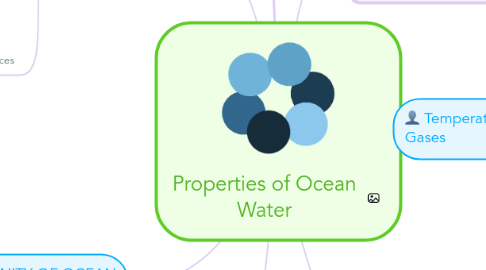
1. Dissolved Solids
1.1. 96.5% pure water and 3.5% dissolved solids
1.2. Most Abundant elements
1.2.1. Chlorine, Sulfur, Sodium, Magnesium, Calcium and Potassium
1.2.2. 85% is salt ( halite) sodium chloride
1.2.3. Trace elements, Gold Zinc, Phosphorus
1.3. Sources
1.3.1. volcanic Erruptions
1.3.2. Chemical Weathering of Rock on land
1.3.3. Chemical Reactions between sea water and newly formed sea floor rocks
2. SALINITY OF OCEAN WATER
2.1. Measure of the amount of dissolved solids and other solids in a given liquid.
2.2. grams of dissolved solids in 1000 g of ocean water.
2.3. Eg. 35 g solids in 1000 g water, then its called as 35 parts salt per 1000 parts ocean water
2.3.1. Also written as Salinity=35 parts per thousand
2.4. Factors that change Salinity
2.4.1. rates of evaporation and precipitation
2.4.1.1. Example?
3. TEMPERATURE OF OCEAN WATER
3.1. Temperature varies depending on depth and location
3.2. Surface Water
3.2.1. Tropical Water 30 degree celcius
3.2.2. North and South Poles - 1.9 degree celcius
3.2.3. pack ice-
3.2.3.1. 5m thick and provides insulation
3.3. Thermocline
3.3.1. layer of ocean water where temperature drops with increase in depth faster than it does in other layers.
3.3.1.1. happens because of the fact that hot water is lighter than cold water
3.4. Deep Water
3.4.1. cold, 2 degree celcius, dense, sinks, more dissolved solids, moves slowly, hence slow currents
4. FACTORS THAT AFFECT DENSITY OF OCEAN WATER
4.1. SALINITY AND TEMPERATURE
5. Colour of ocean water
5.1. Blue
5.2. Phytoplankton
6. Oceans as Carbon Sink
6.1. 60 times as much Carbon as the atmosphere
6.2. dissolves CO2
6.3. Regulates Climate
7. Temperature and Disolved Gases
7.1. cold water dissolves more gases
7.2. Warm water releases gases
7.3. Example a can of soda
7.4. Higher Latitudes and Equatorial Regions have different tendencies of dissolving gasses
8. Dissolved gasses
8.1. Nitogen and Oxygen mai n gases disolved.
8.2. Co2 carbondioxide is also dissolved in large amounts
8.3. Sources
8.3.1. streams, rivers, volcanic erruptions, organisms that live in the oceans, plants, most importantly from the atmosphere.

